Table of Contents
The Guide To Grow And Care For Spurge Plant (Euphorbia)
Knowing a plant's preferences go a long way to creating a thriving environment.
The spurge plant is part of the family euphoria, a genus of flowering plants that will give a unique feel to your landscape and can also be medicinal.
Some euphorbia are common and commercially available, like the poinsettia, while others are grown as ornamentals and highly sought after by collectors. Euphorbia range from tiny ornamental annals to long-lived trees.
A few things all 2000 varieties of Euphorbia have in common are a poisonous milky white sap and highly unique flowering structures. Varieties found in Southern Africa and Madagascar have taken on a cacti-like form, while others take on the appearance of woody shrubs.
Why Plant Spurge
Plant Guru Gardenista once called the spurge plant “absurdly useful,” and we’d have to agree. Several species of Spurge plants have been cultivated as garden plants; among them are the poinsettia, crown of thorns, and snow on the mountain.
Their unique flower structures and vibrant neon green foliage hues make a striking burst of life in the depths of winter. They are also great at creating depth and include varieties that are “ground huggers,” as well as erect euphorbia that creates a great visual breaking point in your landscaping design.
There is a Spurge for every occasion. Aside from giving a unique flowering look among their 2000 family members, Euphorbia constitute perennial, annual, and succulent types.
Lastly, spurge plants are considered a gardener’s “foolproof” go to for their ease of growing. Their flowers can evolve slowly over the seasons and while they are not blooming, their bright foliage makes a wonderful pop of green.They are wonderful for brightening up a dark corner, creating a bouquet, or adding a sense of wonder in your garden.
What Are The Most Popular Types Of Spurge Plant
There are a variety of spurge plants that will work well in your garden depending on your climate zone, color and size specification. Here are some of the most popular spurge plants.
1. Cushion Spurge (Euphorbia polychroma)
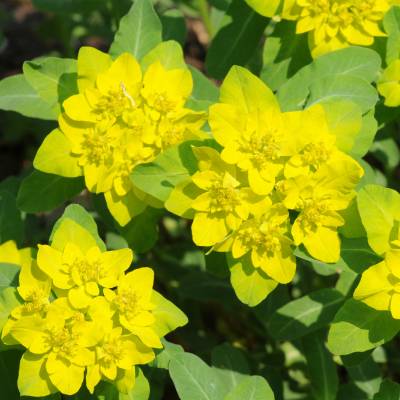
Cushion Spurge (Euphorbia polychroma)
Cushion spurge is a perennial that can grow 12 to 18 inches high. It features bright yellow flower bracts that will bloom in spring. It does best in USDA Zones 4 to 8.
2. Crown of Thorns (Euphorbia milii)
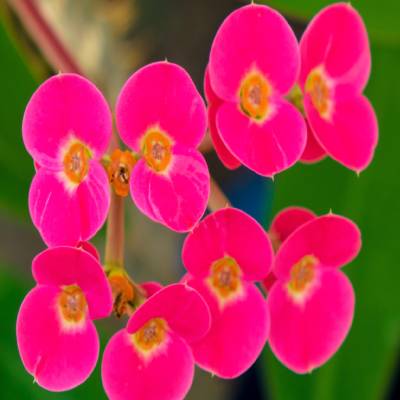
Crown of Thorns (Euphorbia milii)
Crown of Thorns is a bushy evergreen plant that can grow up to six feet tall outdoors. It can be grown as a houseplant but typically won't reach the same size that outdoor growth gives. Different variants offer red, pink, or yellow flowers that bloom repeatedly. Crown of Thorns thrives in USDA Zones 9 to 11.
3. Baseball euphorbia (Euphorbia obesa)
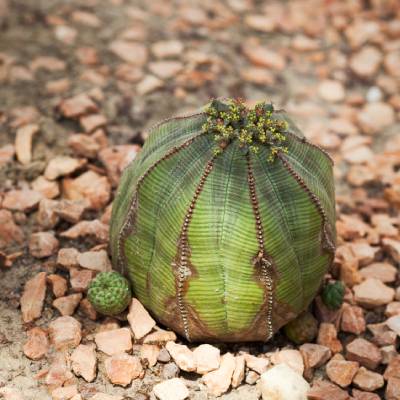
Baseball euphorbia (Euphorbia obesa)
Baseball euphorbia is a small succulent with a round, ball-shaped stem that will grow to become cylindrical as the plant ages. It is usually grown as a houseplant but can also be grown outdoors in USDA Zones 10 to 11.
4. Donkey Tail spurge (Euphorbia myrsinites)
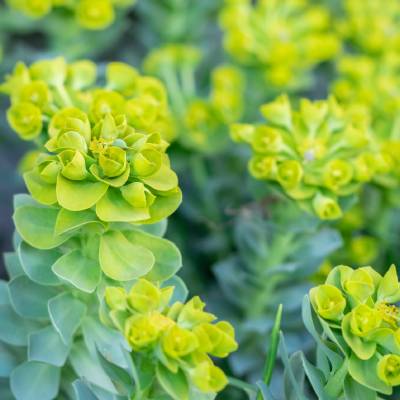
Donkey Tail spurge (Euphorbia myrsinites)
Donkey Tail spurge is an evergreen succulent. Its charactorized by creeping, spiraled bluish green foliage. They will typically grow six to ten inches tall and produce star-shaped yellow bracts. It makes a wonderful edging plant and is often used as a ground cover in USDA Zones 5 to 9.
5. Wood spurge (Euphorbia amygdaloides)
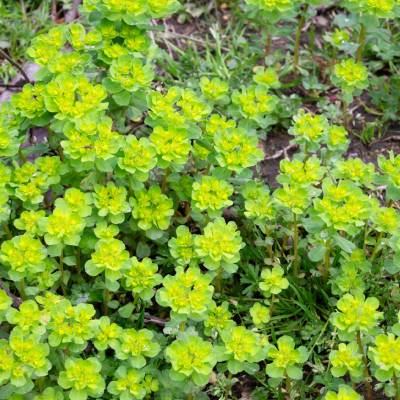
Wood spurge (Euphorbia amygdaloides)
Wood spurge is a bushy evergreen that will grow 18 to 24 inches tall with yellow flowers.. It thrives in USDA Zones 6 to 8.
How To Grow And Care For Spurge Plants
Euphorbias are notoriously easy to care for as long as they have their needs met during establishment, they are reliable, hardy additions to your garden.
Best Methods For Planting
It is best to plant spurge plants in the spring after the threat of frost has passed outside. However, inside, spurge plants can be planted at any time. Be aware that although the toxicity can vary from species to species they can be toxic to animals and humans.
Plant euphorbia, where they can get full sunlight, at least 6-8 hours a day. Some species can tolerate partial shade, and in hot climates, it is advisable to give them partial shade respite from especially intense sunlight periods.
Euphorbia does best in warm environments but can tolerate hotter temperatures. A tolerance to colder weather varies amongst the different spurge species. Some species can handle a light frost, while others will not have success below 55F.
Soil
All species of euphorbias prefer well-draining soil, with a sandy substrate with pH 5- 7 being an optimal environment; succulent varieties especially thrive in soil that is moist but has good drainage. If they are grown in a container, they will do best in a cactus or succulent potting blend.
Watering
Spurge plants will actively need water during their growing periods from spring to fall. Check the soil regularly and water when the top few inches of soil feel dry. During the winter, you can water less and pay attention to signs of wilting and moisten during these periods. If you choose to plant inside, use a porous clay pot that will encourage drainage.
Fertilizing
Fertilizing needs vary amongst species, but in general, all of them can do with some feeding. To promote healthy growth, add compost or a well-balanced organic fertilizer. After the initial feeding, you can maintain it with a liquid fertilizer throughout the growing season. For container-raised plants, you can fertilize more frequently. Look for yellowing leaves as an indicator that a potted spurge needs a feed of fertilizer.
Blooms
Spurge plants typically bloom in the spring or summer and then go dormant in the winter, although their bright green foliage should remain. Perennial garden spurges are highly prized for their yellow bracts, which will bloom mid-spring.
Deadheading and cutting back the spurge after flowering will promote regrowth the following year.
Medicinal Benefits Of The Spurge Plant
Wide varieties of Euphorbia are used for medicinal purposes. Here are a few that are well known.
Euphorbia hirta
Ayurvedic medicine in India has featured Euphorbia hirta as a supportive herb for many ailments. It is a hairy herb that grows wild and in open grasslands. So well known is this plant medicinally that it is nicknamed the “asthma plant.” This plant has been used to aid in female disorders, respiratory ailments, and digestive problems.
Cypress Spurge
The Cypress Spurge is a flowering plant whose roots are used to make natural medicine to aid breathing disorders, diarrhea, and skin diseases.
Milkweed
Many indigenous tribes have used milkweed for wart removal or have chewed the roots to avoid dysentery. It is also used as a salve to treat swelling and rashes. Infusions are thought to relieve colds, fevers, and asthma.
How To Use The Spurge Plant In Bouquets
Varieties of spurge such as Euphorbia oblongata are a florist's favorite. Their candelabra-like stems create jutting exposition against soft floral blooms. There are some special precautions to take when working with spurge bouquet design. Gloves should always be worn to protect from the toxic sap. Sealing the stems with a flame will help them to stop oozing. Finally, try not to cut immature Spurge, or they will wilt quickly.
Spurge can last 7-10 days if they are prepared with care.
Other varieties to grow for future bouquet design include:
- Euphorbia amygdaloides: Evergreen rosettes of dark green leaves and lime green bracts.
- Euphorbia amygdaloides: a maroon stemmed variety.
- Euphorbia characias: blue green leaves that can trail up to 4 feet in length.
- Euphorbia polychroma: bright yellow bracts.
- Euphorbia myrsinites: gray glacous leaves.
- Euphorbia griffithii: young foliage is reddish green and the flowers are orange-red.
Recent Articles

















